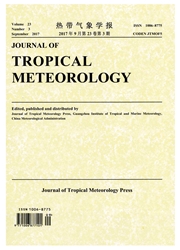

 中文摘要:
中文摘要:
With multiple meteorological data, including precipitation from automatic weather stations, integrated satellite-based precipitation (CMORPH), brightness temperature (TBB), radar echoes and NCEP reanalysis, a rainstorm event, which occurred on May 26, 2007 over South China, is analyzed with the focus on the evolution characteristics of associated mesoscale-β convective systems (Mβcss). Results are shown as follows. (1) The rainstorm presents itself as a typical warm-sector event, for it occurs within a surface inverted trough and on the left side of a southwesterly low-level jet (LLJ), which shows no obvious features of baroclinicity. (2) The heavy rainfall event is directly related to at least three bodies of Mβcss with peak precipitation corresponding well to their mature stages. (3) The Mβcss manifest a backward propagation, which is marked with a new form of downstream convection different from the more usual type of forward propagation over South China, i.e., new convective systems mainly form at the rear part of older Mβcss. (4) Rainstorm-causing Mβcss form near the convergence region on the left side of an 850-hPa southwesterly LLJ, over which there are dominantly divergent air flows at 200 hPa. Different from the typical flow pattern of outward divergence off the east side of South Asia High, which is usually found to be over zones of heavy rains during the annually first rainy season of South China, this warm-sector heavy rain is below the divergence region formed between the easterly and southerly flows west of the South Asian High that is moving out to sea. (5) The LLJ transports abundant amount of warm and moist air to the heavy rainfall area, providing advantageous conditions for highly unstable energy to generate and store at middle and high levels, where corresponding low-level warm advection may be playing a more direct role in the development of Mβcss. As a triggering mechanism for organized convective systems, the effect of low-level warm advection deserves more of our attention. Based on
 英文摘要:
英文摘要:
With multiple meteorological data, including precipitation from automatic weather stations, integrated satellite-based precipitation (CMORPH), brightness temperature (TBB), radar echoes and NCEP reanalysis, a rainstorm event, which occurred on May 26, 2007 over South China, is analyzed with the focus on the evolution characteristics of associated mesoscale-β convective systems (Mβcss). Results are shown as follows. (1) The rainstorm presents itself as a typical warm-sector event, for it occurs within a surface inverted trough and on the left side of a southwesterly low-level jet (LLJ), which shows no obvious features of baroclinicity. (2) The heavy rainfall event is directly related to at least three bodies of Mβcss with peak precipitation corresponding well to their mature stages. (3) The Mβcss manifest a backward propagation, which is marked with a new form of downstream convection different from the more usual type of forward propagation over South China, i.e., new convective systems mainly form at the rear part of older Mβcss. (4) Rainstorm-causing Mβcss form near the convergence region on the left side of an 850-hPa southwesterly LLJ, over which there are dominantly divergent air flows at 200 hPa. Different from the typical flow pattern of outward divergence off the east side of South Asia High, which is usually found to be over zones of heavy rains during the annually first rainy season of South China, this warm-sector heavy rain is below the divergence region formed between the easterly and southerly flows west of the South Asian High that is moving out to sea. (5) The LLJ transports abundant amount of warm and moist air to the heavy rainfall area, providing advantageous conditions for highly unstable energy to generate and store at middle and high levels, where corresponding low-level warm advection may be playing a more direct role in the development of Mβcss. As a triggering mechanism for organized convective systems, the effect of low-level warm advection dese
 同期刊论文项目
同期刊论文项目
 同项目期刊论文
同项目期刊论文
 ANALYSIS OF MESOSCALE CONVECTIVE SYSTEMS ASSOCIATED WITH A WARM-SECTOR RAINSTORM EVENT OVER SOUTH CH
ANALYSIS OF MESOSCALE CONVECTIVE SYSTEMS ASSOCIATED WITH A WARM-SECTOR RAINSTORM EVENT OVER SOUTH CH 期刊信息
期刊信息
